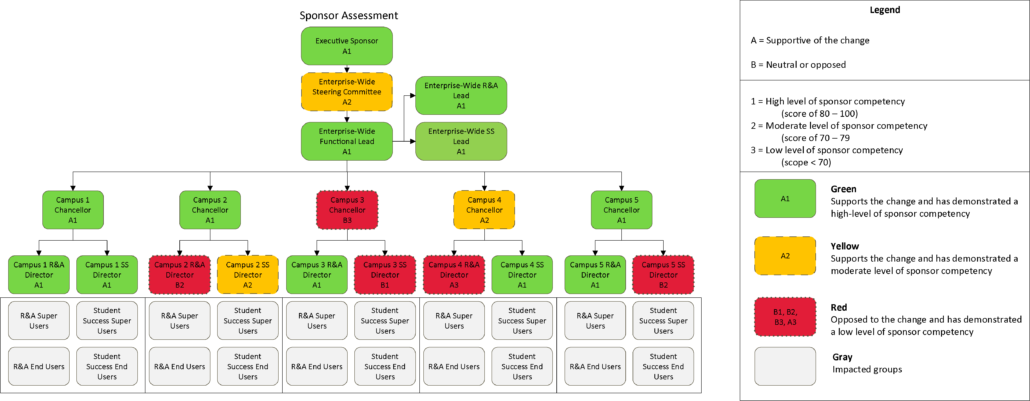
When undergoing a transformational change initiative, having an active and visible executive sponsor is critical for project success. An executive sponsor is the owner of a change initiative and typically an executive or senior staff member that employees trust to guide their organization. If the executive sponsor is not visibly engaged, employees tend to lose sight of the value the change initiative is trying to drive, leading to a higher risk of project failure. Rather than just serving as a sponsor by name, a sponsor’s role in a transformation effort is to be actively involved. Influential sponsors must engage throughout the duration of a project’s lifecycle and remain on the front line to address any obstacles from project planning through post-implementation activities.

Three Ways to Increase Executive Sponsor Participation In Your Change Management Initiative
According to Prosci® Best Practices in Change Management (CM)[1], one of the greatest obstacles for successful change efforts is the lack of active and visible sponsorship support from leadership. Organizations can use the following tactics to mitigate issues stemming from a lack of sponsorship, as illustrated below:

1. Engage Sponsor in Project Activities
The first step is to begin actively including sponsors in project activities. The project sponsor is responsible for setting and driving the vision forward. A regular meeting cadence should be established early in a change initiative to ensure that sponsors are truly engaged. Often, sponsors communicate the change they want to see within their organization without remaining actively visible throughout the transition state. The lack of visibility creates a disconnect between leadership and everyday employees, who will truly be impacted by the sponsor’s long-term vision.
Including a sponsor regularly in a project allows them to be briefed on project updates and help manage risks and issues. It is recommended for the change management team to meet at least 30 minutes per week with the executive sponsor for the project’s duration, but this cadence can vary depending on the project’s size and demand.
Communicating directly with sponsorship can help them stay accountable for the success of the project. Part of a change manager’s role is to be a liaison between the project stakeholders and the executive sponsors by creating an active flow of information and providing communications for the sponsor to share with their constituents. The following mitigation strategies can help navigate some of the resistance that may arise while trying to engage sponsors.
| Resistance | Mitigation Strategies |
| Regards change initiative as low priority | Coach sponsor on effective sponsor strategiesDiscuss how sponsor absence leads to project failure |
| Limited availability to engage in project activities | Create a regular meeting cadence to brief on project activities and risksProvide monthly sponsorship updates |
| Dependence on project team to create vision | Reiterate importance of sponsors to build support with peers and managers and communicating directly with employees |
2. Institute a Sponsor Coalition
The second step is to institute a sponsor coalition to enable leaders throughout an organization to drive forward the project vision. Employees are more likely to resonate with the required changes when they hear from someone they trust. Therefore, it is crucial for a change manager to identify and help the sponsor coalition understand how they can actively demonstrate the desired behaviors and communicate effectively with their employees.
A critical step in building a sponsor coalition is identifying leaders throughout an organization and assessing their readiness and resistance levels. Then, a specific action plan, detailing a roadmap of activities, should be developed to clearly articulate how leadership can engage with their employees. Creating a heatmap, such as the one below, allows the project team to have a clear visual of the additional work that needs to be done to secure active sponsorship. The sponsor coalition should be continuously updated throughout the duration of the project as visible sponsorship may ebb and flow.

3. Provide Sponsor Coaching
The last step is to execute on the sponsor action plans by providing sponsor coaching. Coaching teaches sponsors how to fulfill their new role and guides the rest of the organization through the change curve. The coaching plan encompasses various strategies, including maintaining the sponsor coalition, ensuring an active and visible presence, and managing the resistance from top-down and bottom-up. Sponsor coaching sessions are a great way to review the sponsor coalition map and spread awareness around what actions are needed to achieve project success. Coaching sessions should include:
- Change management education
- External data to build awareness of their role as a sponsor
- Examples of key sponsorship activities and common mistakes
- Self-assessments
Attain Partners’ Approach to Change Management
As change management leaders, we play a critical role in encouraging and supporting change sponsors in their roles. When approaching any change, institutions should develop a structured change management approach to understand the tools that are required to support the initiative and ensure appropriate resourcing to allow sponsors to take on their new role. This will ensure that leadership visibly supports the effort, and focuses on engaging employees, middle-management, and the project team early and often to generate buy-in.
Often the value of change management is underestimated while implementing a change and not realized until it may be too late. Attain Partners provides change management support to Higher Education and Non-Profit organizations to ensure activities meet the institution’s needs. To learn more about effectively managing transformative changes in Higher Education and Non-Profits, please contact us for additional information.
About the Authors

Martina Cook is a Senior Consultant for Attain Partners with experience leading project and change management activities for higher education, nonprofit, academic medical centers, and federal clients. She has led change management efforts for various types of projects including CRM and ERP implementations, as well as organizational and process redesigns. Martina is a Prosci® Certified Change Management Practitioner.

Hitarthi Patel is a Business Analyst for Attain Partners supporting the public sector. She possesses extensive knowledge of change management activities within higher education and nonprofit organizations and specializes in supporting change management activities for CRM implementations. She is a Prosci® Certified Change Management Practitioner.
[1] Prosci Best Practices in Change Management 2016 – 9th Edition, p. 21, 2016, Prosci Inc.

Be the First to Know
Subscribe to our monthly Pulse newsletter
to be the first to hear about new blog posts










